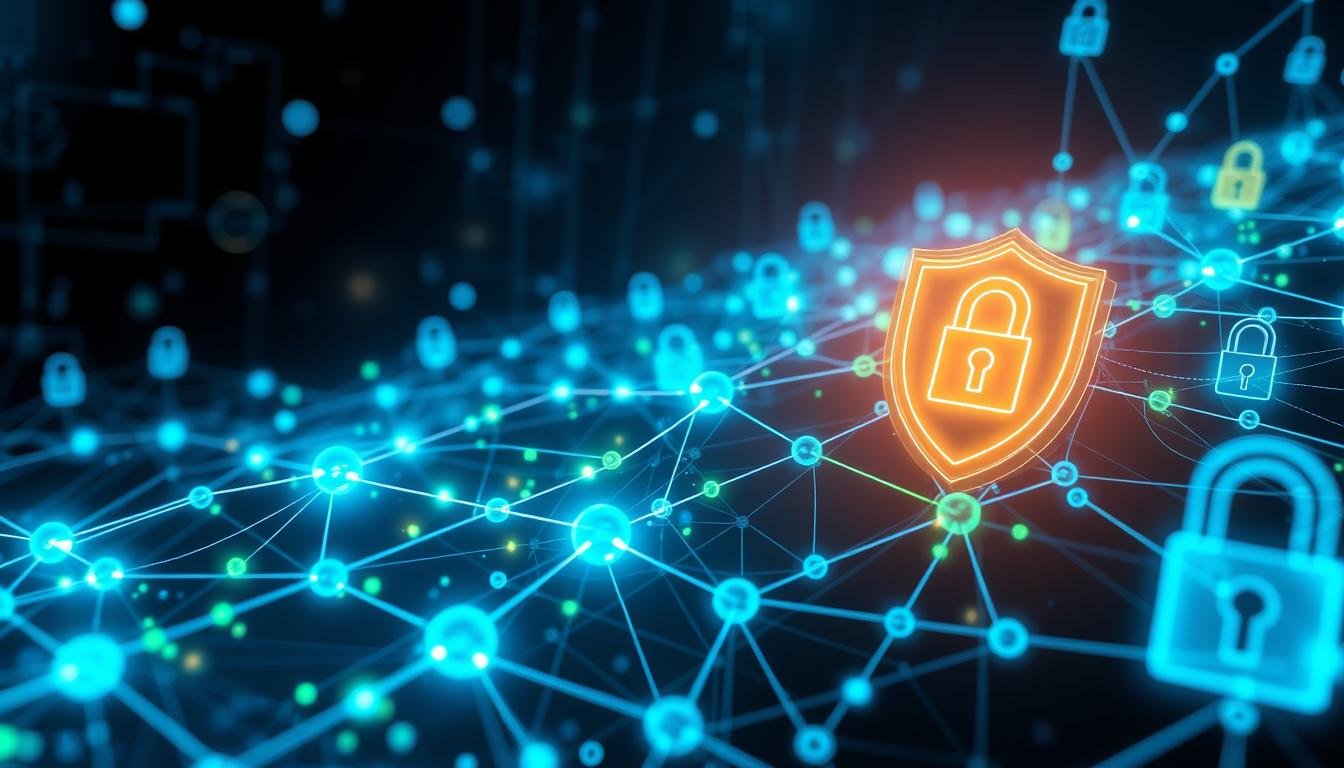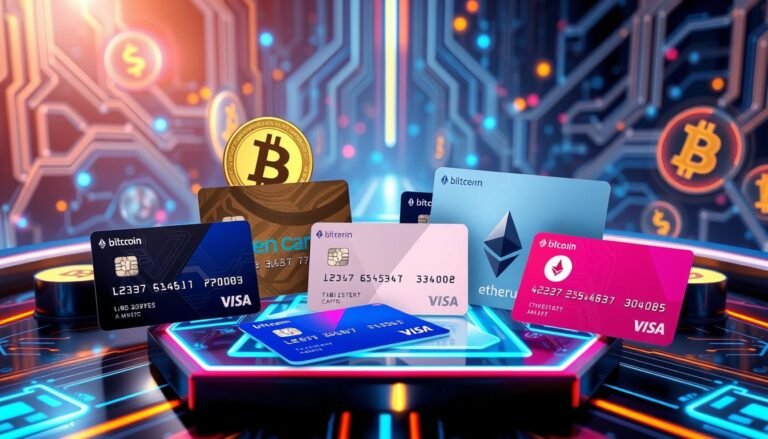Blockchain in Cybersecurity: Enhanced Protection
Blockchain technology is known for its role in cryptocurrency. It’s now seen as a way to boost cybersecurity. Cyber attacks are getting more common and complex, using advanced tech like AI and botnets. Traditional security methods often can’t keep up.
Businesses face new challenges, like securing remote work and BYOD policies. These can make networks more vulnerable. Blockchain offers a secure, transparent way to track and verify transactions.
It helps protect data, validate identities, and boost cyber resilience. Blockchain’s records can’t be changed, thanks to its consensus mechanisms. This makes digital assets and communications safer.
Key Takeaways
- Blockchain technology can enhance cybersecurity by providing a secure, transparent, and decentralized system for tracking and verifying transactions.
- Blockchain’s inherent security features, such as immutable records, cryptographic integrity, and collaborative consensus mechanisms, make it a promising solution for addressing modern cyber threats.
- Blockchain can be applied across various industries, including healthcare, supply chain management, IoT, and more, to improve data protection, identity validation, and overall cyber resilience.
- Implementing blockchain networks requires incorporating traditional cybersecurity best practices, such as risk management, regulatory compliance, and minimum security requirements for participants.
- The combination of blockchain and cybersecurity has gained significant interest from both executives and technology experts, reflecting a growing trend in enhancing security solutions.
Understanding the Role of Blockchain in Cybersecurity
Blockchain technology is a strong tool in cybersecurity. It has many security benefits that help protect data. Its decentralized nature makes it hard to attack, unlike traditional systems.
Inherent Security Advantages of Blockchain Technology
Blockchain uses cryptography, decentralization, and consensus for security. Each block is linked to the last, making data hard to change. This is called immutable records.
Blockchain’s decentralized system means no single point of failure. This makes it hard to stop with DDoS prevention attacks. It’s more secure than systems with one central point.
The collaborative consensus in blockchain makes it even safer. Transactions are checked by many nodes. This, along with strong encryption, keeps data private and trustworthy.
Blockchain also protects IoT protection and supports smart contracts. This makes it great for many industries looking to improve their security.
“Blockchain’s inherent security features, such as decentralization, cryptographic encryption, and consensus-driven validation, make it a game-changer in the field of cybersecurity.”
Blockchain’s security benefits can change how we protect data and control access. It’s a big step forward in cybersecurity.
Types of Blockchain and Their Security Considerations
Public vs. Private Blockchains
Blockchain technology comes in two main types: public and private. Public blockchains, like Bitcoin and Ethereum, are open networks. Anyone can join and help validate transactions. Private blockchains, however, are more exclusive. They use identity controls and access privileges, allowing only certain organizations to join.
Public blockchains are open to anyone, making them decentralized. This means the network stays safe even if some nodes get hacked. But, they face issues with growing too big and using too much energy.
Private blockchains, on the other hand, are more controlled. They use strong identity controls to keep only known entities in. This makes them a good choice for businesses needing to keep data safe.
| Public Blockchain | Private Blockchain |
|---|---|
| Permissionless, open to anyone | Permissioned, restricted access |
| Decentralized, high anonymity | Centralized control, strong identity management |
| Consensus through Proof-of-Work or Proof-of-Stake | Selective endorsement by known organizations |
| Vulnerable to scalability and energy consumption issues | Potential to better satisfy regulatory and compliance requirements |
Choosing between public and private blockchains depends on your security needs and rules. Knowing the differences is key to using blockchain for better security.
Blockchain in Cybersecurity: Enhanced Protection
Blockchain technology is a strong tool in cybersecurity. It offers a tamper-proof ledger and real-time data delivery. This ledger is great for tracking assets and transactions, keeping data safe.
The DARPA blockchain system fights hackers by quickly spotting and stopping data breaches. It also gives real-time info on hackers.
Blockchain’s features like decentralization and cryptographic integrity boost security. They create decentralized trust among users. This trust comes from verifying data ownership and integrity, making passwords less needed.
The blockchain network is hard to change, offering strong defense against attacks. This makes it a solid choice against vulnerabilities in centralized systems.
| Blockchain Type | Description |
|---|---|
| Public Blockchains | Open to anyone to join, with all members able to validate transactions if they choose to. |
| Private Blockchains | Require membership and identifying information to access data. |
| Hybrid Blockchains | Interoperable mix of private and public blockchains. |
Organizations can improve their cybersecurity with blockchain’s tamper-proof ledger and real-time data delivery. This technology helps protect valuable assets and data from threats. As blockchain use in cybersecurity grows, its benefits will become clearer, offering a reliable defense against digital threats.
Potential Cyberattacks and Fraud on Blockchain Networks
Blockchain technology is secure, but it’s not completely safe from cyberattacks and fraud. Hackers use different methods to target these networks. These include code exploitation, employee computer hacking, phishing attacks, routing attacks, Sybil attacks, and 51% attacks.
The DAO was robbed of over $60 million in ether. The Bithumb exchange was hacked, losing $870,000 in bitcoin. These cases show we need strong security for blockchain systems.
Blockchain Security Challenges
- Phishing attacks target users. It’s important to use good antimalware and verified browser extensions.
- Routing attacks can be stopped with strong encryption and secure protocols. Employee education helps too.
- The Sybil attack floods networks with fake identities. Choosing the right consensus algorithms can prevent this.
- The 51% attack happens when one group controls over 50% of mining power. A higher hash rate and secure mining pools are needed.
| Potential Attack | Description | Prevention Strategies |
|---|---|---|
| Code Exploitation | Exploiting code vulnerabilities for unauthorized access or theft. | Secure coding and thorough audits are key. |
| Employee Computer Hacking | Using employee devices to access the network and data. | Good training, device management, and access controls are essential. |
| Stolen Key Attacks | Using stolen private keys for transactions. | Securely store keys, and never share them. |
To fight these threats, blockchain networks need strong security. This includes identity management, regular risk checks, following rules, disaster plans, and strict security policies.
Implementing Blockchain Security for Enterprises
As more companies use blockchain to boost security and transparency, it’s key to follow top cybersecurity practices. This ensures the full benefits of blockchain. A solid plan for blockchain security must cover risk management, regulatory focus, disaster recovery plan, identity verification, access management, and strong security controls.
Blockchain’s decentralized setup and crypto security are great for protecting data. Yet, companies must carefully look at and manage blockchain risks. They need to create a risk model, check for threats, and set up security measures to lessen risks and threats. It’s also vital to make sure the blockchain solution meets legal standards, as laws around it are still changing.
Also, having a detailed disaster recovery plan is crucial to protect against unexpected problems or system crashes. This plan should cover data backup, network backup, and how to handle incidents. It helps keep the business running smoothly and the blockchain operations safe.
Strong identity verification and access management are key to controlling who can use the blockchain network. Companies should use advanced checks like multi-factor authentication and biometric ID. This ensures only the right people can access and change data in the blockchain.
Finally, it’s important to put in place security controls made for blockchain. This includes cryptographic hashing, consensus mechanisms, and secure smart contract coding. These steps help fight the special risks and threats of blockchain networks.
| Security Advantage | Key Benefit |
|---|---|
| Immutability and Tamper-proof Records | Ensures data authenticity and integrity |
| Decentralisation and Distributed Ledger | Protects against single points of failure |
| Cryptography and Consensus Mechanisms | Secure data encryption and integrity |
| Auditability and Traceability | Creates a transparent and auditable record |
By taking a complete approach to blockchain security, companies can use this powerful tech safely. This protects their operations, data, and reputation.
Challenges and Best Practices in Blockchain Security
Organizations want to use blockchain’s security benefits but face many hurdles. They worry about data privacy, scalability, following regulations, and making sure systems work together well.
In public blockchains, anyone can see and get data from transactions. This raises big privacy concerns. But, permissioned blockchains, which only let trusted people in, can help solve these problems. Still, making blockchain work for small and medium businesses is hard because of size and speed issues.
Blockchain’s complex nature also clashes with changing data privacy laws and rules. For example, the “right to be forgotten” in some places is a challenge. Also, making different blockchain systems talk to each other smoothly is tough.
To overcome these issues, there are best ways to do things. These include good key management, strong encryption, and careful API integration. Keeping security up to date and getting audits from trusted groups are also key.
| Challenge | Best Practice |
|---|---|
| Data Privacy | Use permissioned blockchains, strong encryption |
| Scalability | Make block size and transaction times better |
| Regulatory Compliance | Make sure blockchain follows new data privacy laws |
| Interoperability | Make secure API connections between blockchains |
| Key Management | Use detailed key management plans |
By tackling these problems and following best practices, companies can really use blockchain to boost their security. This helps them fight off new threats.
Conclusion
Blockchain technology is a game-changer for cybersecurity. It brings benefits like decentralization, collaborative consensus, strong encryption, and immutable records. These features make it more secure than traditional networks, reducing vulnerabilities and proving data ownership and integrity.
However, using blockchain for cybersecurity comes with its own set of challenges. These include data privacy, scalability, regulatory compliance, and interoperability. Despite these hurdles, blockchain offers a robust solution for enhancing cybersecurity.
Organizations can make the most of blockchain’s security benefits by following best practices. This includes thorough risk assessment, identity and access management, and using both blockchain-specific and conventional security controls. The combination of blockchain with advanced technologies like artificial intelligence and the Internet of Things opens up new opportunities for proactive threat detection and automated response mechanisms.
As blockchain technology becomes more widespread in industries like finance, healthcare, and supply chain management, its impact on cybersecurity will grow. By embracing blockchain’s security benefits and tackling the challenges it presents, businesses can strengthen their defenses against cyber threats. This ensures the integrity and confidentiality of their critical data and assets.
Source Links
- What Is Blockchain Security? | IBM
- The Role of Cybersecurity in Blockchain Technology | UpGuard
- Rethinking Cybersecurity Through Blockchain
- Role of Blockchain Technology in Cybersecurity
- Role of Blockchain in Cybersecurity
- The Importance of Blockchain Security – Chainalysis
- Blockchain and Cybersecurity
- What is Blockchain Security? | Is Blockchain Safe? | Kaspersky
- Blockchain Technology: Enhancing Security in the Digital Age
- Blockchain and Cybersecurity: Enhancing Data Protection and Privacy
- Securing the Future of Banking: Exploring the Synergy of Blockchain and Cybersecurity | Infosys BPM
- Blockchain Security: Understanding vulnerabilities and mitigating risks
- Integrating Blockchain for Enhanced Security Across Industries
- Security in Blockchain: The Benefits of Blockchain Security Services | Microminder Cybersecurity | Holistic Cybersecurity Services
- Council Post: How Blockchain Revolutionizes Data Integrity And Cybersecurity
- Blockchain Cybersecurity: Use Cases, Benefits & Challenges
- How to secure blockchain: 10 best practices | TechTarget
- Blockchain Technology: Strengthening Cybersecurity and Protecting Against Password Leaks and Data Breaches
- The Role of Blockchain in Data Security and Integrity | CMIT Solutions Tribeca






